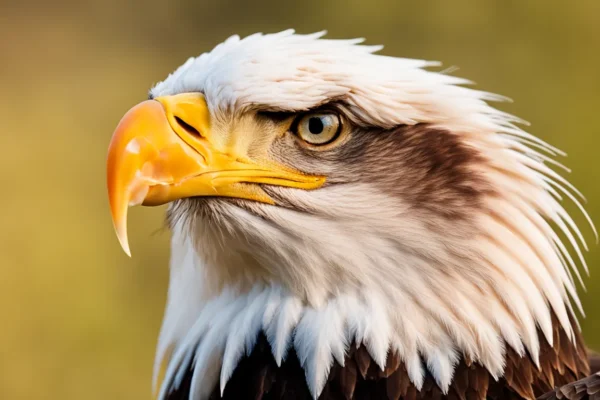Many Native American tribes place great spiritual and cultural value on eagle feathers. Native peoples are connected to their ancestry via its usage in rituals, ceremonies, and clothing. This begs the question, “Is it legal for a Native American to give an eagle feather to someone else?”
This is a simple response in case you’re pressed for time: Indeed, loopholes to wildlife protection rules allow enrolled members of federally recognized Native American tribes to lawfully give or receive eagle feathers under certain circumstances.
An Overview of Eagle Feather Symbolism and Applications
Eagle feathers are revered and regarded as potent spiritual emblems in Native American societies. They are intricately linked to the religious and cultural customs of several American tribes.
While various tribes may have distinct meanings for eagle feathers, in general, they are said to symbolize power, knowledge, and a link to the divine.
Indian Cultures’ Sacred Status
Feathers from eagles are highly valued and are regarded as gifts from God. They are used in a variety of rites and ceremonies, and it is thought that they transport prayers to the spiritual world. Native Americans believe that eagles are messengers and spiritual bridges, and that touching an eagle’s feathers may help one establish a spiritual connection.
Eagle feathers are traditionally earned rather than just given. In the tribe, they are often given out as a mark of valor, honor, or accomplishment. By following this procedure, it is guaranteed that those who have shown a profound appreciation and respect for their cultural heritage will get the feathers.
Parts in Ceremonies and Rituals
Eagle feathers are essential to Native American ceremonies and rites. They are often used in powwows, dances, and other cultural gatherings. Feathers are often fashioned into headdresses, regalia, and other ceremonial garments, signifying the wearer’s spiritual connection with the eagle.
Eagle feathers may be used in smudging or cleaning ceremonies, when they are passed through smoke to cleanse participants as well as the area around them. In prayer rituals, they may also be waved or held to channel energy and establish a connection with the divine.
It is essential to remember that there are rigorous cultural norms and laws around the usage of eagle feathers in Native American rituals. By following these procedures, you may be guaranteed that the feathers are utilized with decency and in line with tribal customs.
The preservation of their cultural legacy and the continued holy and significant usage of eagle feathers are matters of considerable concern to Native Americans.
Visit the National Congress of American Indians website at www.ncai.org for further details on Native American cultural customs and the meaning of eagle feathers.
Laws Defending Feathers and Eagles
There are rules in place to safeguard these magnificent birds and their feathers when it comes to Native Americans and the giving of eagle feathers. The Bald and Golden Eagle preservation Act and the Migratory Bird Treaty Act are two significant legislation that control the preservation of eagles and their feathers.
Protecting Bald and Golden Eagles Act
In 1940, the Bald and Golden Eagle Protection Act (BGEPA) was enacted to prohibit the hunting, catching, killing, or possession of bald and golden eagles’ feathers or parts without a permission. With the exception of those who are members of Native American tribes that have received federal recognition, it is unlawful to own, sell, or exchange eagle feathers or parts under this statute.
Eagle feathers and parts are available for purchase from the National Eagle Repository or other authorized sources for Native Americans who are enrolled members of a federally recognized tribe. Given the great spiritual and cultural significance that eagles have for many Native American tribes, these licenses are given to them for religious and cultural reasons.
Act of Migratory Bird Treaties
In order to prevent eagles and other migrating birds from being killed, trapped, hunted, or owned in any way without a permission, the migrating Bird Treaty Act (MBTA) was passed in 1918. More than a thousand bird species are protected by this statute, including eagles, whose feathers are legally protected.
Native Americans are also covered by the MBTA, which permits them to own eagle parts or feathers for cultural and religious reasons. Under the terms of the MBTA, Native Americans are still need to get licenses from the U.S. Fish and Wildlife Service in order to lawfully possess eagle feathers or parts.
It’s important to remember that the purpose of these regulations is to safeguard and preserve eagle populations so that they continue to exist for next generations. The illicit trade in eagle parts and feathers, which may have a negative effect on eagle populations and their habitats, is lessened when these rules are enforced.
Visit the official websites of the National Eagle Repository (www.fws.gov/eaglerepository) and the U.S. Fish and Wildlife Service (www.fws.gov) for further information on the laws protecting eagles and their feathers.
Allowances for Use by Native Americans
Although it is normally forbidden for anybody in the US to own or give eagle feathers as a gift, Native Americans are allowed to utilize these priceless artifacts for cultural and religious reasons.
These exclusions are meant to safeguard Native Americans’ rights to pursue their cultural practices while acknowledging the importance of eagle feathers in Native American customs.
Procedure for Applying for Permits
In order for Native Americans to lawfully own or give away eagle feathers, they had to apply for permits. This procedure is governed by the U.S. Fish and Wildlife Service (USFWS), which requests that applicants submit an application outlining their request’s goals.
Every application is assessed individually by the USFWS, which takes into account many aspects including the applicant’s cultural customs, planned use of the feathers, and tribe connection.
Remember that having a permit does not give you unrestricted access to eagle feathers. The quantity of feathers that may be owned or given as gifts, as well as the precise situations in which they can be utilized, are strictly regulated by the USFWS.
This keeps eagle populations intact and enables Native Americans to carry out their traditional rituals.
Proof of Enrollment Is Needed
Native Americans are required to provide documentation of membership in a federally recognized tribe along with their permission application. This rule aids in preventing those who may not have proper claims to Native American ancestry from abusing eagle feathers.
A tribal identity card, a Certificate of Degree of Indian Blood (CDIB), or other formal documents proving the individual’s tribal status might serve as proof of enrollment.
This is an essential step to guarantee that the only people who may really own and give eagle feathers are individuals who are authentically tied to Native American customs.
It is important to note that various tribal groups may have somewhat varied regulations regarding the ownership and giving of eagle feathers. Certain tribes have established restrictions that may need extra paperwork or involve a slightly different procedure.
As a result, in order to learn the precise laws and regulations that apply to them, people must speak with the appropriate tribal officials.
The U.S. Fish and Wildlife Service’s official website, www.fws.gov, provides further details on the laws and rules pertaining to the ownership and distribution of eagle feathers.
Requirements & Restrictions for Feathers Gifting
For Native American tribes, giving an eagle feather as a gift has great cultural and spiritual value. But legally speaking, there are a few requirements and restrictions that need to be taken into account while giving feathers.
It is important to comprehend these restrictions in order to guarantee adherence to legal requirements and honoring Native American customs.
The Act to Protect Bald and Golden Eagles
The Bald and Golden Eagle Protection Act (BGEPA), passed in 1940, is the main statute controlling the ownership and giving of eagle feathers. This federal statute prohibits the unlawful possession, sale, acquisition, or barter of any bald or golden eagle component, including feathers, without the required license.
Interesting fact: In 1782, the bald eagle was designated as the national bird of the United States. It represents power and independence.
Legal Eagle Feathers Possession
There are certain exceptions to the BGEPA’s prohibition on owning eagle feathers. It is permissible for Native Americans who are enrolled members of tribes that have received federal recognition to own and utilize eagle feathers for cultural, religious, or spiritual reasons.
Fascinating fact: There are presently 574 officially recognized tribal nations in the United States, according to the U.S. Fish and Wildlife Service.
Giving Away Feathers in Native American Cultures
Eagle feathers are often given as gifts among Native American groups as a sign of respect, appreciation, and honor. It is crucial to remember that there are rules and conventions to abide by even in these societies.
Did you know that in many Native American traditions, eagles are revered as holy birds and are often connected to strength, knowledge, and spirituality?
Limitations for Non-Native People
It is often forbidden for non-Native people to own or give away eagle feathers, even to those who may have inherited them or obtained them in another way. This aims to stop eagle feathers from being illegally traded and commercialized, which might endanger attempts to conserve these magnificent birds.
Noteworthy: There are severe fines and punishments, including jail time, for breaking the BGEPA.
Legal Resources for Feathers Gifting
Purchasing eagle feathers from approved sources is essential if you want to do it legally for gifts. Eagle feathers for religious and cultural purposes are made available to enrolled members of federally recognized tribes via the National Eagle Repository, run by the U.S. Fish and Wildlife Service.
Practical source: Visit the National Eagle Repository’s official website to learn more about the organization and the procedure for getting feathers: Eagle Parts Native American https://www.fws.gov/index.html
Honoring the customs of Native Americans
Giving eagle feathers as gifts requires observance of Native American customs and cultural norms. The best course of action is to confer with community cultural counselors or tribe elders to make sure that the gift-giving procedure is carried out in a polite and suitable manner.
Recall that giving feathers as gifts is a holy custom that calls for respect and consideration.
Final Thoughts
Eagle feathers are protected by federal law, but they also have great cultural and spiritual significance for many Native Americans. By permitting registered tribe members to lawfully give feathers as gifts under certain circumstances, an exception system aims to strike a compromise between traditional rights and environmental objectives.




![13 Birds with Big Mouths [Some are Really Scary]](https://birdsology.com/wp-content/uploads/2022/10/29-600x400.jpg)


2 thoughts on “Can A Native American Legally Gift An Eagle Feather?”